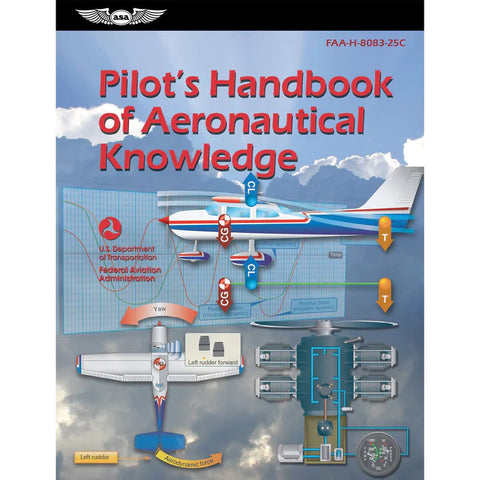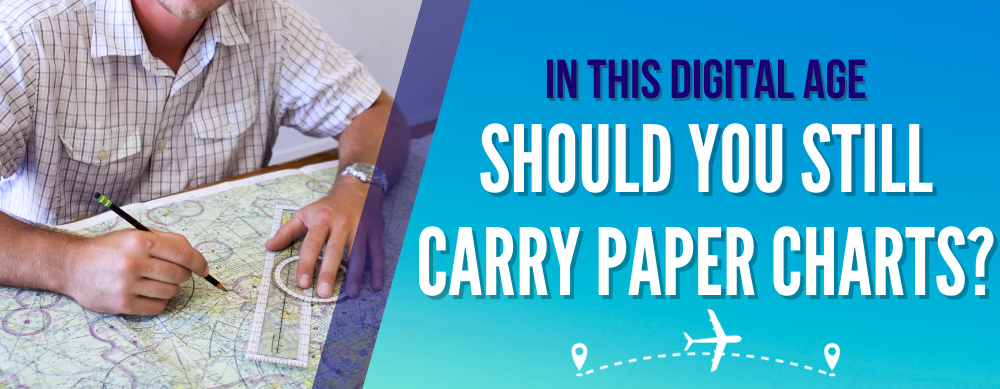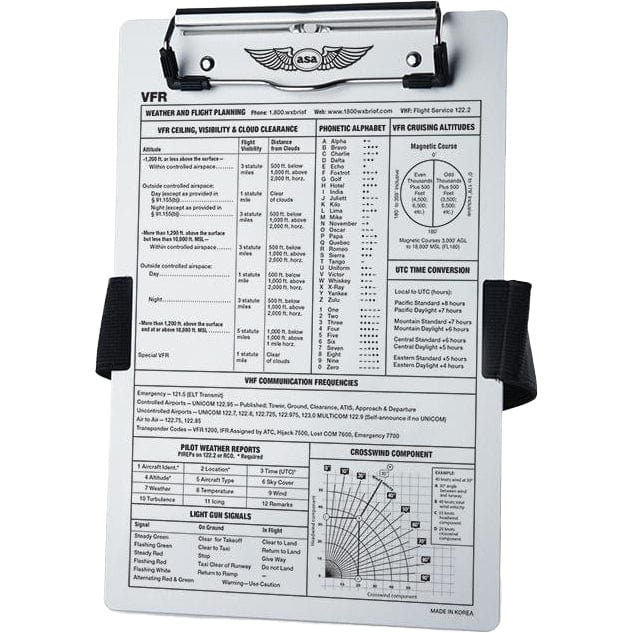Are sectional charts becoming obsolete? With the advancement and widespread adoption of electronic flight bags since receiving FAA approval in the early 2000s, there has been a growing movement towards ditching traditional paper charts.
Before we jump on this bandwagon, let's weigh the pros and cons of both paper and electronic aviation charts. After all, when it comes to safety in the cockpit, we want to make sure we're making the most informed decision.
So, is it time to say goodbye to paper charts or do they still have a valuable place in our arsenal?
Let’s take a look at both the pros and cons of paper charts and electronic aviation charts, then you decide the verdict.
 Pros of Paper Charts
Pros of Paper Charts
Before we jump headfirst onto the digital bandwagon, let’s first consider the merits of traditional paper charts.
Reliable Backup
Are you familiar with the phrase, “Two is one; one is none.”? Even if you use digital charts as your primaries, there is a lot of comfort and peace of mind in having a real, tangible physical chart in your cockpit.
Imagine holding both your electronic flight bag and your paper charts at waist height, then dropping them on the tarmac. Just the thought makes you cringe, doesn’t it? There’s something to be said for your paper charts which, unlike their digital counterparts, won’t stop working or disappear when they hit the ground.
No Batteries Required
All you need to be able to use your paper charts are the charts themselves – and maybe a light and reading glasses. Digital devices however, will always need a power source to function.
If the thought of arriving at the airfield only to realize that your digital device won’t power up sounds like a nightmare, carrying a set of paper charts is a low-maintenance backup plan.
Provide Big Picture for Flight Planning
During pre-flight planning, it helps to see the big picture. While digital charts can be zoomed out, the total map area is still only as big as your device’s screen. This may make it harder to get a broad-scale view.
Laying paper sectionals out on a table can provide a better perspective in the planning phase.
 Cons of Paper Charts
Cons of Paper Charts
If digital charts are the wave of the future, there must be a reason, right? What is it about paper charts that you and your fellow pilots gripe about?
Size and Weight
One electronic device is substantially less bulky and heavy than toting around a case filled with paper sectionals, terminal area charts (TACs), VFR planning charts and other required files.
Not Backlit
What color light do you use to illuminate a paper chart at night? Red light may preserve your night vision, but it can also make those magenta colors practically disappear.
Digital charts are designed to be viewed in both day and night without the need for a flashlight since the adjustable backlight function allows you to optimize screen brightness.
Need for Multiple Charts
There is no magical pinch and zoom option on a paper chart. To switch between sectionals and TACs, you have to physically pull out and juggle multiple paper charts.
As a side note, you also have the dubious pleasure of practicing your origami skills when you continually refold your sectionals throughout the flight.
Logistics of Updating Charts
Are you sick and tired of remembering to R&R your physical charts every 56 days when they expire?
Wouldn’t it be great if those charts could simply be updated with the press of a button? This is one of the benefits of digital charts.
Additional Skill Requirements
Yes, you know how to navigate using dead reckoning and pilotage. Does that mean that you want to perform those mental gymnastics with each flight? Probably not, but with paper charts, you don’t have a choice.
 Pros of Electronic Flight Bags
Pros of Electronic Flight Bags
What is so exciting about the high-tech electronic flight bag (EFB) option? These sophisticated apps and dedicated devices expand upon the capabilities of basic paper charts by offering next-level features.
Ease and Speed of Updating
With EFBs, gone are the days of ordering, waiting for, and remembering to replace expiring paper charts. All charts, airport information and other important data are easily updated within the app or digital software.
Weather Data Overlay Feature
Save precious time by quickly overlaying weather data directly on your flight map.
Customizability
Digital charts contain a wealth of data and they give users the ability to select which information to view at any given time. Pilots can set up their system to their personal preferences and add or remove chart layers as desired.
Integrated Charts
Rather than switching between a sectional and a terminal area chart as you would with paper versions, the digital chart of an EFB seamlessly transitions between the two with the pinch and zoom feature.
Flying from Tampa to New York? Your sectionals will naturally load in correct sequence without any distracting paper chart swapping maneuvers required.
Less Bulk + More Charts
Whatever type of EFB you choose, it will inevitably allow you to carry more charts while still taking up less space and weight than a full set of paper charts.
Tablet accessories like kneeboards and mounts give you the freedom to position your EFB device wherever is best for you.
Moving Map Display
Pair your EFB with a portable GPS/ADS-B device and you will be able to view your aircraft’s real-time position overlaid on your chart.
Computational Capabilities
ETEs, ETAs, and other moving calculations can be done real-time and without as great a potential for human error.
Imagine being able to pull up the vector and distance to the nearest airport at the touch of the button during an emergency landing scenario.
 Cons of Electronic Flight Bags
Cons of Electronic Flight Bags
This new tech sounds like magic, but if making the switch to digital was the clear-cut right answer, you would have jettisoned your paper charts years ago. That said, let’s have some real talk about the downsides of digital.
Technical Issues
Any electronic device has the potential to fail. Rely solely on a single EFB with no paper backup, and you run the risk of technical issues rendering your charts ineffective. Remember – Murphy’s Law applies to airplanes as well.
Battery Requirements
Unlike paper charts that can languish in your flight bag between uses, an EFB device must be properly charged to work. Leave your battery or charger at home, and your device is useless.
Screen Size
A tablet-sized screen may be large enough in-flight, but during planning for a long flight, you may find that you prefer to be able to view your route on larger, printed sectionals.
Potential for Losing Skillsets
Math teachers dread the day they must teach their class how to use a calculator rather than arriving at the solution using manual equations. The fear is that students will become completely reliant on the technology and unable to function without it.
The same concern applies to EFBs. You may wish to ask yourself how secure you are in your navigation skills. If your EFB were to stop functioning, are you able to quickly pull out backup paper charts and continue without a problem, or would you be dangerously rusty?
What’s Your Verdict?
Only you can decide what navigational aids belong in your cockpit. Having grown up with sectionals, it may just boil down to mental comfort. Carrying paper charts as a backup for now will simply feel like the right thing to do, while using an EFB for the actual flight.
This hybrid approach provides the maximum safety and redundancy of time-honored traditions while exploring and benefiting from new technologies.

|
ASA Pilot's Handbook of Aeronautical KnowledgeProviding basic knowledge essential for all pilots, from beginning students through to the advanced certificates, this Federal Aviation Administration (FAA) publication introduces readers to the broad spectrum of knowledge required as they progress through pilot training. |
Want more aviation guides?
Our guides are designed to help student pilots become professional pilots and for private pilots to brush up on their knowledge and skills.
-
How To Fly Turns Around A Point (Complete Guide + Lesson Plan)
- Cloud Ceilings: What Pilots Should Know (Complete Guide)
Did you find this article helpful?
Do you think we missed anything important? Let us know in the comments below!







9 comments
Mike Kelly
Grew up with paper charts starting in 1964. Love the crisp feel of them when they are new, opening them up, and plotting a cross country with them. I’ve got first rate GPS navigators in the 3 airplanes I maintain and operate, plus an I-fly GPS unit. But the Sectionals, neatly folded and stacked so that they are ready, come along on every trip. The airplanes flown include a classic “fastback” straight tailed Cessna 150, a beautiful vintage 35K Bonanza, and a Stearman. The charts aren’t regularly used in the Stearman for obvious reasons, but they are tucked away and at the ready if needed. Mike Kelly, “Old School Aviator” and CFI
Larry Kay Adair
I use electronic charts by use of Fore Flight but always have a paper backup, “Just in case”!
Bill North
I have been flying off and on for over 50 years so I guess you can call me dinosaur. Paper charts are the only way to go. I flew with another instructor who used an I-Pad. I kept my sectional on my knee because I was comfortable…which is the key word. I do not feel comfortable with electronic charts. If you’re not comfortable as a pilot, then you become agitated and distracted and may make mistakes. I support those “kids” who use electronic charts. But for my money, paper charts are the way to go. Thanks for listening to a dinosaur.
Ernie
Today’s flying requires good SA ( situation awareness).. EFB can make your workload so much less…assuming you are smart enough to have a backup device if everything goes south. Garmin Pilot with a good ads-b in device provides more info on multiple devices.
Paper is how we grew up, now with smart devices(phones, iPad, etc is the way unless you can afford a new avionics panel.
James Flourentzou
I’m old school, did my training using paper charts and I’ve actually never used EFB, not saying that I wouldn’t. I’d be happy to try but will definitely keep paper charts as a backup.
Carl Raymond Cox
EFB’s are a must have in today’s technology, However, to not carry Paper Navigation Chart’s is dangerous and fool hardy. Like not carrying a few basic tools, fuse’s ETC.
LoneStarHog
I remember in the early days of computers (circa 1960s), and continuing for decades, the saying, “Computers will do away with paper…” Uh, yeah!
My computer data files of the most critical information, I have paper backup. The same philosophy applies to my flight bag.
Retired IBM (1967-1997)
Serge
For safety, I want at least 2 independant electronic devices. A paper backup is always quite welcome.
Gary Porter
Love paper charts. Still carry them. Have moving maps but like to mark up charts